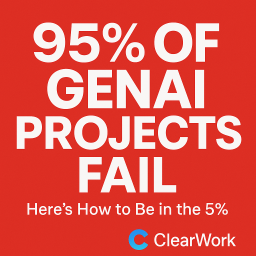
The headline is sensational — and yes, it’s based on the recent MIT study claiming that 95% of GenAI projects fail.
But here’s the truth: GenAI is more successful than people think. Organizations are achieving impressive results, from automated customer support to AI-driven process optimization. The real problem? Far too many projects fail to reach their full potential, stalling out or never scaling beyond a pilot. And the root cause almost never lies with the technology.
It’s the business processes — and the organizational complexity surrounding them — that quietly undermine success.
Executives often believe they can “plug in” GenAI and instantly modernize their business. But here’s the reality:
Without this clarity, organizations point AI at the wrong problems, automate broken processes, and create complexity instead of efficiency.
AI can’t transform what you don’t understand.
GenAI initiatives fail for the same reasons most digital transformations fail:
This is why process intelligence — real-time, ground-truth visibility into how work actually happens — is the missing link for sustainable AI success.
ClearWork is purpose-built to close the gap between AI ambition and operational reality.
Here’s how we do it:
ClearWork tracks actual user activity across enterprise applications in real time, providing a data-backed map of “as-is” processes — no interviews, no assumptions.
Our platform identifies bottlenecks, inefficiencies, and automation opportunities that would otherwise stay hidden, helping leaders prioritize where GenAI can deliver the greatest ROI.
With a clear view of reality, teams can confidently design optimized, AI-enabled workflows that integrate human expertise with intelligent automation.
Forget months-long mapping efforts. ClearWork gets you actionable insights in days, so you can launch, iterate, and scale GenAI initiatives with confidence.
If you want to be among the organizations that succeed with GenAI, start here:
This isn’t theory — this is the blueprint that ClearWork customers are using to drive transformation with clarity and precision.
The promise of GenAI is real. But to realize that promise, organizations must stop treating AI like magic and start building on a foundation of process clarity.
With ClearWork, you gain unparalleled visibility into your operations, empowering you to align AI investments with real-world processes — and avoid becoming just another statistic in that 95% failure rate.
The next generation of AI winners will start with clarity, not chaos. ClearWork makes that possible.
It’s rarely the AI itself. Most failures come from broken or misunderstood processes — incomplete process data, siloed workflows, slow discovery methods, and poor adoption. AI can’t transform what you don’t understand.
Process intelligence provides real-time, ground-truth visibility into how work actually happens. With accurate process maps and insights, leaders can prioritize the right workflows, avoid automating inefficiencies, and design AI that scales.
ClearWork delivers:
The winners won’t treat AI like “magic.” They’ll start with process clarity, align AI with real-world operations, and continuously optimize. ClearWork ensures your GenAI investments deliver measurable, sustainable value.

GenAI success is grounded in the specific of your organization. When you understand your processes you have the foundation for success. Let's chat!
Enjoy our newsletter!